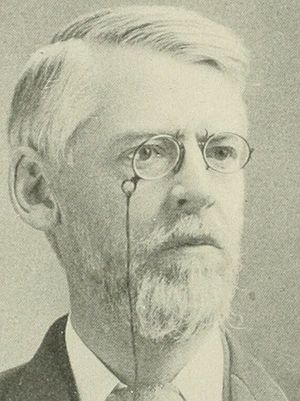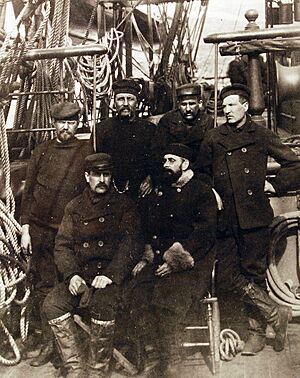William E. Chandler facts for kids
Quick facts for kids
William E. Chandler
|
|
|---|---|
 |
|
| United States Senator from New Hampshire |
|
| In office June 14, 1887 – March 3, 1889 |
|
| Preceded by | Person Cheney |
| Succeeded by | Gilman Marston |
| In office June 18, 1889 – March 3, 1901 |
|
| Preceded by | Gilman Marston |
| Succeeded by | Henry E. Burnham |
| 30th United States Secretary of the Navy | |
| In office April 16, 1882 – March 4, 1885 |
|
| President | Chester A. Arthur |
| Preceded by | William H. Hunt |
| Succeeded by | William Whitney |
| Personal details | |
| Born |
William Eaton Chandler
December 28, 1835 Concord, New Hampshire, U.S. |
| Died | November 30, 1917 (aged 81) Concord, New Hampshire, U.S. |
| Political party | Republican |
| Spouses | Ann Gilmore Lucy Lambert Hale |
| Children | 1 |
| Education | Harvard University (LLB) |
| Signature | |
William Eaton Chandler (December 28, 1835 – November 30, 1917) was an important American lawyer and politician. He served as the United States Secretary of the Navy and later as a U.S. Senator for New Hampshire. In the 1880s, he was part of the "Half-Breed" group within the Republican Party. This group supported making the government hiring process fairer, based on skill rather than connections.
Chandler strongly supported civil rights, even after the Reconstruction period ended. He believed President Rutherford B. Hayes was too soft on the Southern states. As Secretary of the Navy, Chandler started a big project to modernize the U.S. Navy. He made sure new ships were built with strong, modern steel.
Contents
Early Life and Education
William E. Chandler was born in Concord, New Hampshire. His parents were Nathan S. Chandler and Mary Ann (Tucker) Chandler. He had an older brother, John, who was a successful merchant. His younger brother, George, was a lawyer and a major in the Civil War.
William went to local schools, including Thetford Academy and Pembroke Academy. He then studied at Harvard Law School. While there, he started writing letters to Lucy Lambert Hale, who was the daughter of Senator John P. Hale. William finished law school in 1854 and became a lawyer in Concord in 1855.
In 1859, Chandler married Ann Gilmore, whose father was Governor Joseph A. Gilmore. After Ann passed away, William married Lucy Hale in 1874. Their only son, John Parker Hall Chandler, was born in 1875.
Political Career
In 1859, Chandler became the official reporter for the Supreme Court of New Hampshire. He then served in the New Hampshire House of Representatives from 1862 to 1864. He was the Speaker of the House for his last two years there.
Civil War and Reconstruction Era
In 1865, President Abraham Lincoln appointed Chandler to work for the Navy Department. He later became the First Assistant Secretary of the Treasury until 1867. During this time, Chandler supported voting rights for African Americans.
He also disagreed with some Republicans about the power of large businesses and railroads. Chandler was concerned about protecting African Americans in the South after the Civil War. He felt that military protection might not last forever.
In 1868, Chandler gave testimony during the impeachment trial of President Andrew Johnson. Later, in 1876, Chandler helped the Republican Party win the presidential election for Rutherford B. Hayes. He worked to make sure Hayes won in Florida, believing there had been voting problems.
After this, Chandler returned to New Hampshire. He worked as a newspaper publisher and editor in the 1870s and 1880s. He also continued in politics, serving in the State constitutional convention in 1876 and the State House of Representatives in 1881.
In 1882, President Chester A. Arthur chose Chandler to be the Secretary of the Navy. Chandler was a "Half-Breed" Republican and a friend of James G. Blaine. He served in this role until 1885.
When Chandler became Secretary, the U.S. Navy was quite old-fashioned. Its best warship, the USS Tennessee, was made of wood. Other countries, like Britain, were already building steel warships. Both President Arthur and Chandler believed the U.S. Navy needed a major update.
In 1882, Congress allowed the Navy to build two modern steel ships. The next year, more funding was approved for two additional steel vessels. Under Chandler's leadership, plans were made for the USS Chicago, USS Boston, USS Atlanta, and the USS Dolphin. These ships were known as the ABCDs.
Chandler insisted that these new warships be built in the United States. This helped American shipyards and factories grow. Even though it took time for the country to be ready for such big projects, Chandler set the stage for a modern, steel-built U.S. Navy.
Rescue of the Greely Polar Expedition
In 1883, a U.S. Army scientific expedition led by Lt. Adolphus Greely was stranded in the Arctic. Their ship, the Proteus, had dropped them off in 1881 but then left. Two earlier attempts to resupply or rescue them had failed. The Proteus was even crushed by ice during the second attempt.
The Greely party moved to a new camp, Camp Clay, on Pim Island. They faced extreme hardship and starvation. President Arthur formed a group to figure out how to rescue them. Secretary of War Lincoln wasn't very interested, but Secretary Chandler was determined to succeed. He wanted to save the Greely party and restore the Navy's reputation.
Chandler put Commander Winfield Schley in charge of the 1884 rescue mission. Chandler spent a lot of money to make sure the rescue was successful. He even bought a strong sealing ship, the USS Bear, for $100,000 before he had official permission.
On July 17, 1884, Commander Schley successfully rescued the Greely party. He telegraphed Chandler to report the good news. Out of the original expedition, only seven men survived, though one died soon after the rescue.
U.S. Senator for New Hampshire
As a Republican, Chandler was elected to the United States Senate in 1887. He filled a vacant seat and served until 1889. He was then reelected and served from 1889 to 1901. He tried to be re-nominated but was not successful.
During his time as Senator, he led several important committees. These included the Committee on Immigration, the Committee on Census, and the Committee on Privileges and Elections.
In 1892, Chandler suggested a one-year ban on immigration. He wanted to keep out people he called "undesirables," such as those carrying diseases, anarchists, or people without enough money. He also proposed that immigrants should meet educational or financial requirements. Shipping companies strongly opposed this idea because it would hurt their business. A less strict version of his bill, called The Chandler Immigration and Contract Labor Bill, became law in 1893. It mainly required shipping companies to provide detailed lists of their passengers.
In 1900, Chandler was one of only two Republicans who voted against the Gold Standard Act.
Later Years (20th Century)
In 1901, President William McKinley appointed Chandler to the Spanish Treaty Claims Commission. Chandler was the president of this commission until 1907, helping to settle claims related to the Spanish-American War.
In 1907, Chandler was the main lawyer in a legal case called the Next Friends Suit. This case was about the estate of Mary Baker Eddy, the founder of the Christian Science church. The trial was widely reported in the news.
After leaving public office, Chandler continued to practice law in Concord and Washington, D.C..
Death and Burial
William E. Chandler passed away in Concord in 1917. He was buried in Blossom Hill Cemetery in Concord.
Legacy
The USS Chandler (DD-206), a Navy ship, was named in his honor.
Chandler's grandson, Theodore E. Chandler, joined the U.S. Navy in 1911. Theodore became a rear admiral and was a hero in World War II. He was killed in action in January 1945 during the Battle of Lingayen Gulf.
Images for kids







